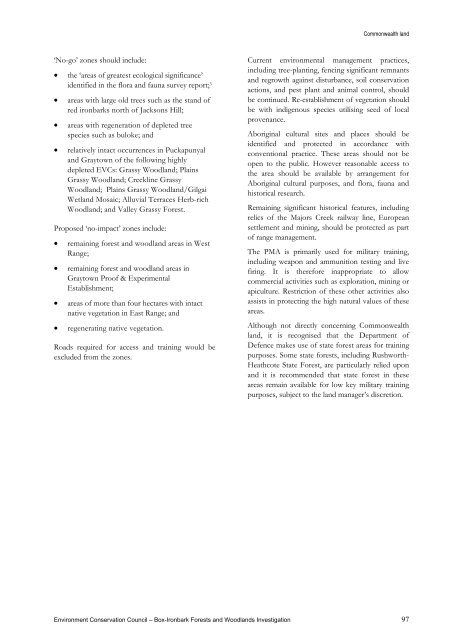Chapter 13 - Victorian Environmental Assessment Council
Chapter 13 - Victorian Environmental Assessment Council
Chapter 13 - Victorian Environmental Assessment Council
You also want an ePaper? Increase the reach of your titles
YUMPU automatically turns print PDFs into web optimized ePapers that Google loves.
Commonwealth land‘No-go’ zones should include:• the ‘areas of greatest ecological significance’identified in the flora and fauna survey report; 3• areas with large old trees such as the stand ofred ironbarks north of Jacksons Hill;• areas with regeneration of depleted treespecies such as buloke; and• relatively intact occurrences in Puckapunyaland Graytown of the following highlydepleted EVCs: Grassy Woodland; PlainsGrassy Woodland; Creekline GrassyWoodland; Plains Grassy Woodland/GilgaiWetland Mosaic; Alluvial Terraces Herb-richWoodland; and Valley Grassy Forest.Proposed ‘no-impact’ zones include:• remaining forest and woodland areas in WestRange;• remaining forest and woodland areas inGraytown Proof & ExperimentalEstablishment;• areas of more than four hectares with intactnative vegetation in East Range; and• regenerating native vegetation.Roads required for access and training would beexcluded from the zones.Current environmental management practices,including tree-planting, fencing significant remnantsand regrowth against disturbance, soil conservationactions, and pest plant and animal control, shouldbe continued. Re-establishment of vegetation shouldbe with indigenous species utilising seed of localprovenance.Aboriginal cultural sites and places should beidentified and protected in accordance withconventional practice. These areas should not beopen to the public. However reasonable access tothe area should be available by arrangement forAboriginal cultural purposes, and flora, fauna andhistorical research.Remaining significant historical features, includingrelics of the Majors Creek railway line, Europeansettlement and mining, should be protected as partof range management.The PMA is primarily used for military training,including weapon and ammunition testing and livefiring. It is therefore inappropriate to allowcommercial activities such as exploration, mining orapiculture. Restriction of these other activities alsoassists in protecting the high natural values of theseareas.Although not directly concerning Commonwealthland, it is recognised that the Department ofDefence makes use of state forest areas for trainingpurposes. Some state forests, including Rushworth-Heathcote State Forest, are particularly relied uponand it is recommended that state forest in theseareas remain available for low key military trainingpurposes, subject to the land manager’s discretion.Environment Conservation <strong>Council</strong> – Box-Ironbark Forests and Woodlands Investigation 97
















